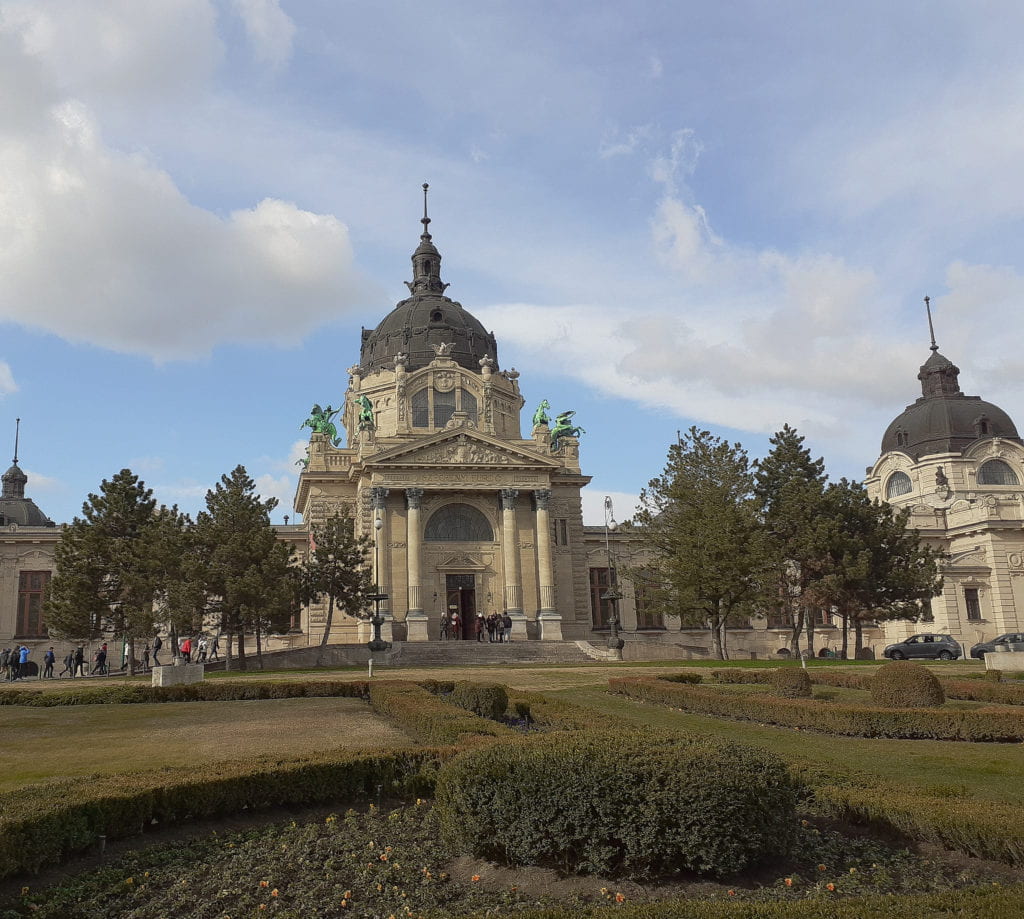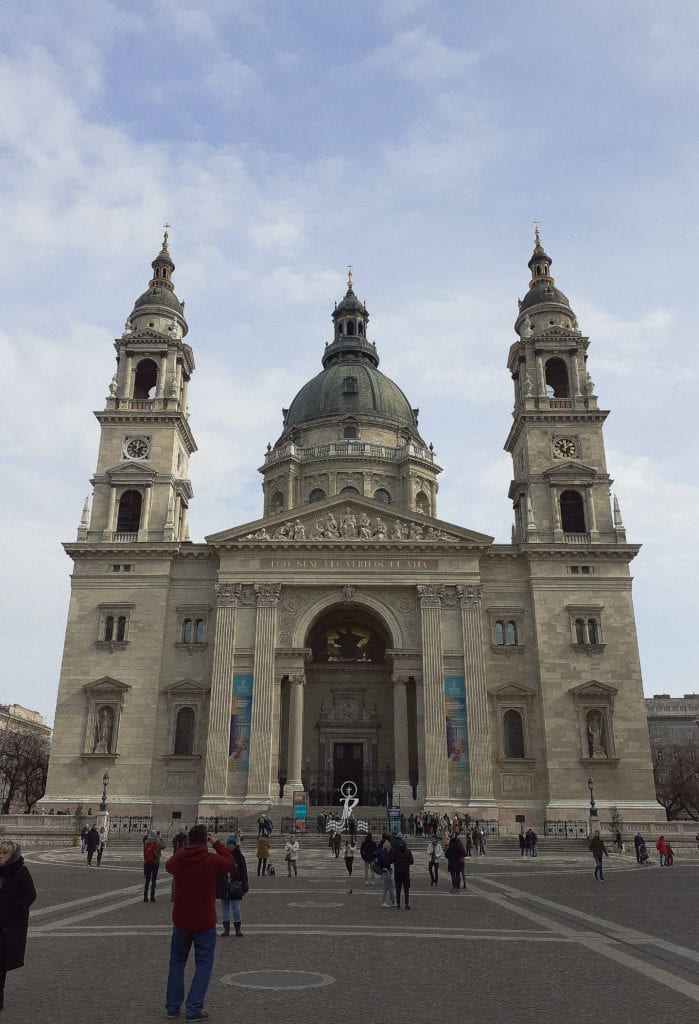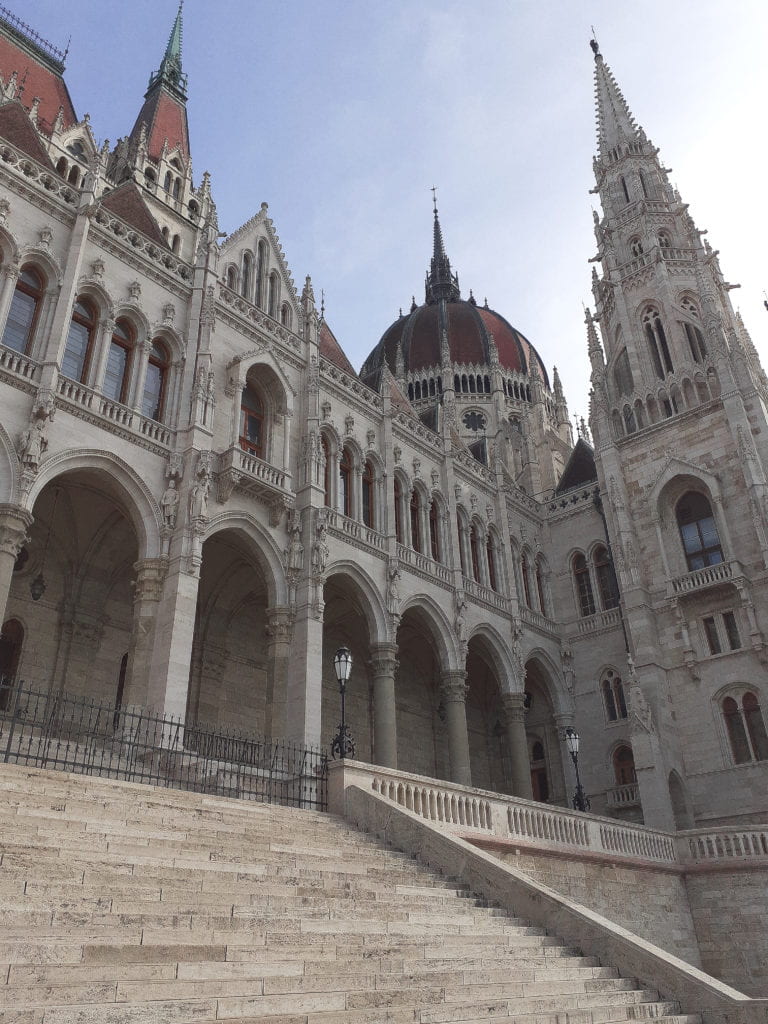Monday, May 18, 2020 | Written by Blanca
*Disclaimer: This story takes place in February before the travel restrictions and shelter in place mandates.*
This post picks up after my first full day in the glorious city of Budapest (featured in My (AirBnB) in Budapest), most of which I spent on the Buda side, west of the Danube. The next morning, armed with an itinerary that involved seeing more of Pest, I once again set off on foot for some more adventuring. My first destination was Hősök tere, or Heroes’ Square, which is a large, open-air square in Pest most notably boasting the Millenium Monument, a cluster of statues honoring the Seven chieftains of the Magyars and major Hungarian leaders. To get there, I walked down the grand Andrássy Avenue. Earlier, my Airbnb host, George, had mentioned that Andrássy Avenue is very much like the Champs-Elysees in Paris. I had scoffed a little at the time, but after having traversed both famed avenues, I realize I should’ve never doubted George’s words (and, as I write this, I’m noticing that George was right about practically everything). Andrássy Avenue is an equally grand and striking boulevard, flanked with shopping centers, dining establishments, and, closer to Heroes’ Square, a smattering of neo-Renaissance mansions and townhouses. Some of these, I realized, were actually foreign embassies, which made the street seem even more stately and dignified. Bathed in rays of sunshine and peeking from behind leaves just beginning to sprout from the tree branches, the elegant exteriors seemed to take on a golden glow. If George Ezra, another George whose word about Budapest is always to be trusted, had actually had a beautiful house in Budapest, I imagined it would be in the area along Andrássy Avenue.

On either side of the Millennium Monument in the center of Heroes’ Square is a neoclassical building with grand columned porticos and ornately adorned pediments. Both are actually prominent art museums (yay!), with the Museum of Fine Arts on the left and the contemporary Hall of Art on the right. I absolutely wanted to go into both, but having spent most of the day at the Hungarian National Gallery the day before, I resignedly decided to diversify my activities and stroll around the Budapest City Park instead. The Városliget, or City Park, was by no means a downgrade, though. Located in it, just behind the Millennium Monument, was Vajdahunyad Castle, an eclectic architectural feat whose variety of styles made it rather whimsical and inviting. Entering the castle gates, I was surprised to find a church and a rather Austrian Baroque-looking building, which I learned was the Magyar Mezőgazdasági Múzeum, or the Hungarian Agricultural Museum. My visit in the latter didn’t last long, but from the ticketing area, I could see vaulted ceilings and many more sets of deer antlers than I’d ever seen in one place—and I live in the middle of nowhere in Pennsylvania. Europe’s largest agricultural museum certainly doesn’t disappoint, even from the lobby.

Across the street from the Vajdahunyad Castle was the Széchenyi Thermal Bath, the largest of Budapest’s well-known thermal baths. Though I didn’t enter the spa (something about being in the same bath as a large crowd of tourists while a new virus was going around didn’t really sit well with me), I’ve heard from many who also visited Budapest that any of the baths are worth checking out.

All this walking was resulting in me being pretty hungry in Hungary. Leaving the City Park, I once again embarked on the long but pleasant walk down Andrássy Avenue toward Budapest’s Jewish Quarter. Though once a ghetto during World War II, nowadays the neighborhood is heralded for its celebration of Jewish culture, and rightfully so. Filled with lively ruin bars and vivid murals on the sides of buildings, the Jewish quarter was spirited, welcoming, and full of life—and some of the best food in Budapest. I stopped at Mazel Tov, an airy cultural space filled with warm lights and greenery, for their famed Mediterranean dishes, where I happened to have the best falafel of my life with hummus, sumac eggplant salad, and a delicious pistachio raspberry cake (who knew that pistachios and raspberries go so well together?).
The next day—my final full day in Budapest—was spent doing what is perhaps my favorite city activity: walking around and simply looking at everything. The architecture, urban planning, pedestrians, and even the way local residents drive paint a very telling picture of what a particular place is like, and Budapest was no different. There’s also something humbling but rather gratifying about standing on the very stones where the bygone regimes of Ottoman Turks and Austrian Habsburgs once ruled, passing present-day residents who were hurrying off to work or carrying home bags of groceries, and realizing that I would have been just as insignificant before as I was now. Knowing that you’re so small in comparison to everything else around you is perfect for shedding any inhibitions and endeavoring to see anything and everything you want to see (and also a good reminder that traveling alone can be extremely dangerous without thorough planning and caution—don’t skimp on measures like mapping out your routes and sharing your location with those you trust).

I paid the St. Stephen’s Basilica a quick visit, doing a precursory Wikipedia read and finding that, for a period of time, it was forbidden for any buildings in Budapest to be constructed taller than the basilica. With a stature of 96 meters, St. Stephen’s Basilica is as tall as the Hungarian Parliament Building and tied for the tallest in Budapest. Speaking of Budapest’s salient parliament house, that was my next stop. After admiring the building from afar the night before, I didn’t think it could be any more beautiful up close. As I am with most things, I was wrong. The meticulous detail of the exterior stonework is positively sublime, and I wondered if the inside was just as splendid. Unfortunately, while entry is free before 8AM, I happened to be there in the early afternoon, which was really quite heartbreaking.

Since the sun was making a rare appearance, I paused and spent some time along the east bank of the Danube River, parallel to the parliament building. I’d always assumed that Strauss’ The Blue Danube Waltz was simply named so because “blue” emphasizes the tranquility of the waltz, but sitting on a bench and looking over to Buda while the wind mercilessly whipped me in the face, I realized that the Danube is actually quite literally the bluest river I have ever seen. So much for being deep and profound. As you can see, traveling is full of learning opportunities, no matter how obscure.

I spent the rest of the day forging a meandering path around Pest, passing bustling shopping areas, ducking into quiet cathedrals, and venturing onto less-traveled streets. Doing so was perhaps my favorite part of my entire visit, and along the way, I came to realize that much of the beauty I’d seen depicted about Budapest in photos and film is quite true. Take, for instance, that 1987 image of a woman perusing a fresh produce marketplace in Budapest (which has recently been recreated), carrying her nonchalant baby in the same bag as a curiously large leek, which paints grocery shopping in Budapest as a serene, leisurely activity: after stopping at a grocery store for some huge strawberries and delicious blood oranges, I can confirm that grocery shopping in Budapest is indeed remarkably almost idyllic. Then again, maybe that was just the strawberries talking. And after stepping into the lobbies of the New York Café and Párisi Udvar Hotel, both of which sport ornate ceilings, opulent décor, and warm lighting that radiates soft, glowing light, the stunning visuals of Wes Anderson’s The Grand Budapest Hotel seem less fantastic and more like a pretty accurate depiction. While many cities are often viewed through rose-colored glasses, with Budapest, you can toss tinted shades; the city and its ambiance are already rosy enough.
